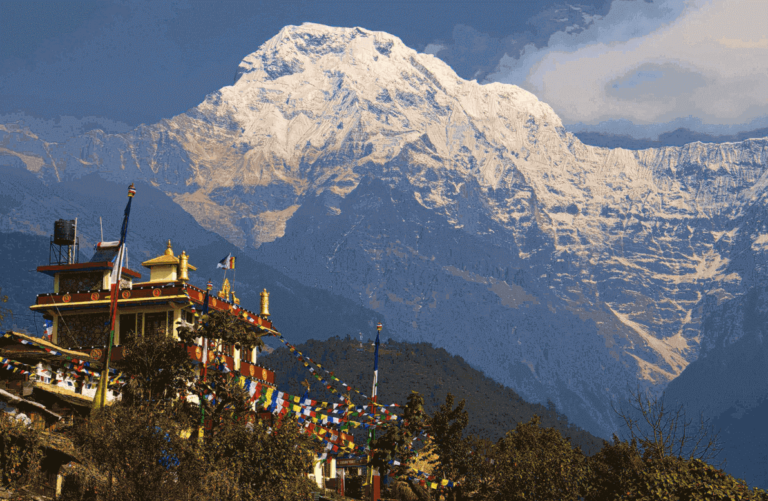Pokhara, a popular tourist destination in Nepal, has recorded the highest air pollution levels in the country today, according to the Department of Environment. The Air Quality Index (AQI) in Pokhara’s Gandaki Boarding area reached a staggering 187, placing it in the unhealthy category. An AQI level above 150 is considered unhealthy, posing risks to everyone, especially sensitive groups.
The AQI scale, which measures air quality, categorizes levels from good to hazardous, with an AQI above 50 considered unhealthy. According to the Department of Environment, air quality deteriorates significantly in the winter months, especially from December to June, as weather patterns trap pollutants in the air.
Pokhara, located in Nepal’s Gandaki Province, was closely followed by Bharatpur in Chitwan with an AQI of 170, indicating unhealthy air quality. The city’s air pollution levels also continue to rise, contributing to the growing health concerns in the region. Bharatpur ranked second in air pollution, according to monitoring data collected by the Ministry of Forests and Environment.
Other Polluted Areas in Nepal
The Department of Environment also highlighted other areas that reported unhealthy air quality levels on February 12. Bhaisepati, located in the outskirts of Kathmandu Valley, recorded an AQI of 154, ranking third among the most polluted locations in the country. Ratna Park, a central area in Kathmandu, also reported an AQI of 151, indicating unhealthy air.
Other areas severely affected by air pollution today included Khumaltar, Shankha Park, Bhaktapur, and Dhulikhel. All of these locations reported AQI levels that exceeded the threshold of 150, making the air potentially hazardous to health.
Yesterday, Shankha Park in Kathmandu had the highest pollution level in Nepal, with an AQI exceeding 208. This marks a significant decline in the city’s air quality over the past 24 hours, which is alarming for public health, especially for those living with pre-existing respiratory conditions.
Global Comparison and Concerns
While Nepal’s air quality continues to deteriorate, global air pollution levels are also rising. Kathmandu ranked as the seventh most polluted city in the world today, with an AQI of 161, according to data from IQAir, a global air quality monitoring platform. The ranking serves as a stark reminder of the increasingly hazardous levels of air pollution in Nepal’s capital.
Hanoi, Vietnam, topped the list of the most polluted cities globally today, with an AQI of 213, followed closely by Wuhan, China, which ranked sixth with an AQI of 163. Delhi, India, came in eighth with an AQI of 160. This comparison highlights how cities in the South Asian region are struggling with similar environmental challenges, affecting millions of people across these regions.
The increasing air pollution is attributed to various factors, including rising vehicle emissions, industrial growth, and seasonal weather patterns that trap pollutants in the atmosphere. Nepal, particularly Kathmandu Valley, faces a unique set of challenges related to topography and climate, which make it particularly vulnerable to pollution.
Health Risks and Government Warnings
The Department of Environment has been warning about the health risks associated with poor air quality. According to the department, an AQI of 0-50 is considered good, while 51-100 is moderate, and 101-150 is unhealthy for sensitive groups. Air quality levels ranging from 151-200 are unhealthy, while 201-300 is very unhealthy and above 301 is hazardous.
Given the high AQI readings in multiple areas, the department has urged the public to take necessary precautions. Children, elderly individuals, pregnant women, and those with respiratory or heart conditions are especially vulnerable to the harmful effects of air pollution. Experts suggest wearing masks, limiting outdoor activities, and staying indoors during the peak pollution hours, especially for sensitive groups.
In a bid to combat this issue, the government has been encouraging residents to reduce their use of private vehicles and increase their reliance on public transportation. Officials have also emphasized the importance of reducing industrial emissions and adopting cleaner energy sources to address the root causes of air pollution in the region.
A Closer Look at Air Quality and Its Impacts
Air pollution, particularly fine particulate matter (PM2.5), has been a growing concern in Nepal. Studies show that long-term exposure to polluted air can lead to various health problems, including respiratory issues, heart disease, and even premature death. The most vulnerable populations, including children, the elderly, and people with pre-existing health conditions, are at the greatest risk.
Moreover, the rising pollution levels have also had a detrimental effect on the country’s tourism industry, which depends heavily on Nepal’s natural beauty. As air quality deteriorates, the once-clear views of the Himalayas have become obscured by smog and haze, disappointing both locals and visitors. Environmentalists have raised concerns about the long-term consequences of this pollution on Nepal’s ecosystems.
Steps Towards Improvement
To address the growing concerns, both the Nepal government and local authorities have been making efforts to tackle air pollution. Initiatives like tree planting drives, promoting electric vehicles, and improving waste management are among the solutions being explored.
Despite these efforts, experts believe that more comprehensive and sustained actions are required to see significant improvement. They stress that the government must invest in sustainable infrastructure, better monitoring systems, and stronger environmental policies to curb the increasing air pollution levels across the country.
The record-high air pollution levels in Pokhara today are a stark reminder of Nepal’s ongoing struggle with environmental degradation. With authorities sounding the alarm and urging the public to take preventive measures, it is crucial for everyone to understand the serious health risks posed by such pollution.
For more news updates on air quality and environmental issues in Nepal, visit Nepal Monitor.


